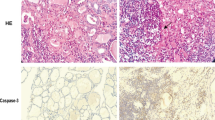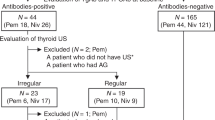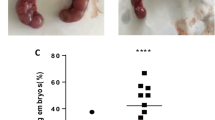Abstract
Objective: To investigate the cellular and molecular mechanisms of some Chinese drugs on apoptosis of thyrocytes in Graves’ disease.Methods: Two to ten weeks before and after using Chinese drugs on 13 Graves’ disease patients with anti-thyroid drugs, patients’ thyroid tissue was aspired with percutaneous puncturing needle. The effects of some Chinese drugs on thyrocytes was studied by applying cell morphology (stained with nuclear fast red, NFR), flow cytometry (stained with propidium iodide, PI), and terminal uridine deoxynucleotidyl end-labelling (TUNEL) technique (alkaline phosphatase and CBIP/NBT, NFR). The size of thyroid gland was measured by color Doppler ultrasonography.Results: After Chinese drug treatment, compared with single anti-thyroid drug group, the size of thyroid was significantly reduced (P<0.01). The apoptosis of thyrocytes can be observed by cell morphology such as chromatin condensation and nuclear fragmentation. The apoptosis rate is 18.66% ±20.01% (n=13) in anti-thyroid drugs plus Chinese drugs group, 2.11% ±1.78% (n= 13) in single anti-thyroid drug group (P<0. 01). For up to 2–10 weeks, more TUNEL-positive cells were found after treatment with Chinese drugs than those treated with anti-thyroid drug alone.Conclusion: Some Chinese drugs when used in combination with anti-thyroid drugs in treating Graves’ disease could induce apoptosis of thyrocytes.
Similar content being viewed by others
References
Green DR, Cotter TG. Introduction: Apoptosis in the immune system. Semin Immunol 1992;4:399.
Watson RW, Rotstein OD, Nathens AB, et al. Thiol-mediated redox regulation neutrophil apoptosis. Surgery 1996; 120(2):150–158.
Watson AJ, Askew JN, Benson RS. Poly (adenosine diphosphate ribose) polymerase inhibition prevents necrosis induced by H202 but not apoptosis. Gastroenterology 1995; 109(2):472–482.
Tsujitani S, Shirai H, Tatebe S, et al. Apoptotic cell death and its relationship to carcinogenesis in colorectal carcinoma. Cancer 1997; 77(8): 1711–1716.
Takiya S, Tagaya T, Takahashi K, et al. Role of transforming growth factor βj on hepatic regeneration and apoptosis in liver diseases. J Clin Pathol 1995; 48 (12): 1093 -1097.
Gaffney EF, O’Neill AJ, Staunton MJ. In situ end-labelling, light microscopic assessment and ultrastructure of apoptosis in lung carcinoma. J Clin Pathol 1995; 48(11): 1017 -1021.
Kotani T, Aratake Y, Hirai K, et al. Apoptosis in thyroid tissue from patients with Hashimoto’s thyroiditis. Autoimmunity 1995;20(4):231–236.
Dremier S, Golstein J, Mosselmans R, et al. Apoptosis in dog thyroid cell. Biochem Biophys Res Commun 1994; 200 (1):52–58.
Branet F, Caron P, Camallieres M, et al. Bel-2 proto-onco-gene expression in neoplastic and non-neoplastic thyroid tissue. Bull Cancer Paris 1996;83(3): 213–217.
Author information
Authors and Affiliations
Rights and permissions
About this article
Cite this article
Zhao, J., Gao, L., Liu, X. et al. Preliminary study on chinese drug- induced apoptosis of thyrocytes in graves’ disease. CJIM 6, 196–199 (2000). https://doi.org/10.1007/BF02950926
Issue Date:
DOI: https://doi.org/10.1007/BF02950926




